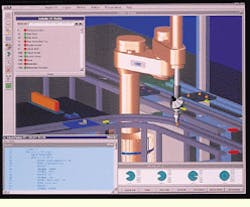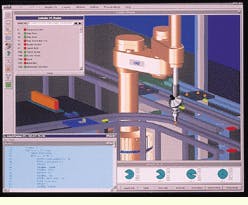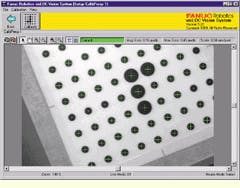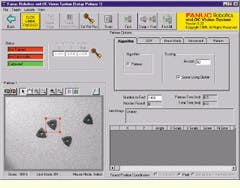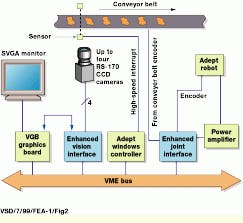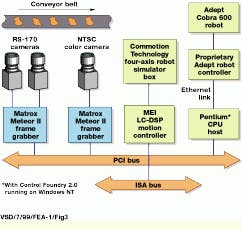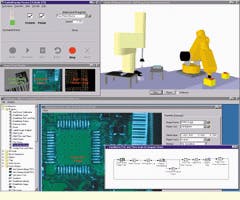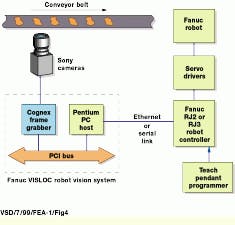Robot vendors use virtual models
Robot vendors use virtual models to simulate Robotic Vision Systems
Andrew Wilson
Editor at Large
Manufacturers of high-volume automotive parts, pharmaceuticals, semiconductors, and plastics are under increasing marketing pressure to reduce costs. To achieve production savings, many such vendors are using automated robotic systems for materials handling and packaging. While these systems are somewhat effective, they rely heavily on precise handling fixtures so that robotic-control mechanisms can accurately move, place, or package parts.
In the semiconductor industry, for example, pick-and-place machines have long used vision-guided robotic systems to ensure that parts are accurately placed on printed-circuit boards (PCBs). In such systems, object-recognition software locates a part and its orientation. Then, the parts-positioning coordinates are transferred to the pick-and-place machine for proper placement. Despite production cost advantages, vendors of robotics systems have often added vision as an afterthought, usually contracting with third-party OEMs to backwardly integrate vision into semiconductor placement systems.
Recognizing this design restriction and the advantages of eliminating costly parts-fixturing mechanisms, many robotic-system vendors are integrating third-party machine-vision tools into their robotic simulation software. Accordingly, systems developers can now chose from a range of tools that allow both sophisticated robots and image-inspection tasks to be simulated off-line. In this way, designers can model the actions of the robot and test the vision-based algorithms from one development system, reducing development costs and speeding product time to market.
Nowhere was this trend more apparent than at the recent International Robots & Vision Show and Conference (Detroit, MI; May 11(13). There, at least three vendors showed integrated simulation and vision-guided robotic packages that perform a number of pick-and-place, image-inspection, and complex motion-control tasks. Interestingly, while Adept Technology (San Jose, CA) highlighted VME-based systems, Fanuc Robotics North America (Rochester Hills, MI) showcased hybrid-PC and proprietary systems, and Commotion Technology (San Francisco, CA) presented a PC-based work-cell control application.
Three-dimensional simulation
To allow systems integrators to program robotic systems without the physical robot or cell hardware being present, manufacturers, including Adept Technology and Commotion, offer three-dimensional (3-D) robotic-assembly-simulation software. The Adept Digital Workcell, for example, allows developers to anticipate and/or identify cycle times, program logic errors, unreachable location errors, collision errors, and motor saturation errors early in the development process.
"Typically, a robot workcell must be completely built before any programming can begin, delaying the entire process by weeks. Using the Digital WorkCell, this process can be cut by as much as one-half," says Joe Campbell, vice president of marketing for Adept Technology. His company demonstrated Digital WorkCell running under a proprietary V+ programming language, real-time operating system (RTOS), and software that included MotionWare for robot pick and place, VisionWare for vision inspection, and AIM PCB for PCB applications. The software`s library of Adept robots and modules allows developers to program precise virtual models of physically and kinematically accurate mechanisms (see Fig. 1). Additional features include prebuilt standard application cells, fully editable and kinematically enabled workcell peripherals, automatic collision detection, and payload dynamic checking capability.
To add vision capability to its VME-based Digital Workcell system, Adept uses the AdeptVision VXL vision system that consists of ObjectFinder object-recognition software and an enhanced vision interface board and a VME-based module, custom-built for the company by Imaging Technology Inc. (Bedford, MA). In operation, the board can be used to interface to as many as four TM1001 RS-170 cameras from Pulnix America (Sunnyvale, CA) and the Adept VGB VME-based graphics-display module (see Fig. 2).
To train the system to recognize an object, developers use the ObjectFinder software included in AIM VisionWare to perform such functions as geometry-based object recognition, normalized gray-scale correlation, blob analysis, edge detection, and image manipulation. At the May conference, Adept`s AdeptVision VXL vision system was used to locate unfixtured parts along a conveyor belt. After parts location, an Adept 600 four-axis robot was used to simulate the application of adhesive to the perimeter of the part.
Third-party packages
While the Adept demonstration proved the viability of robot-assisted vision, it also highlighted the trend toward PC-based machine control. Even as Joe Campbell expounded the virtues of RTOSs and proprietary architectures, Adept Technology announced it would use Matrox Electronic Systems (Dorval, Quebec, Canada) as its imaging hardware vendor for the company`s next-generation vision product. According to Adept, Matrox hardware technology will provide a platform for the Adept vision toolbox and for ObjectFinder. Matrox will supply vision hardware that will be incorporated into Adept controllers and combined with the ObjectFinder vision tool.
Adept Technology was not the only company adding third-party vision capability to its product line at the Robots & Vision Show. In its booth, Fanuc Robotics North America (Rochester Hills, MI) demonstrated its proprietary R-J3 system controller directing a 3-D intelligent assembly system, the Fanuc Robot!-21I (see Fig. 3). Said Rick Schneider, Fanuc`s president and chief executive officer, "Integrating the Fanuc RJ3 controller with the PC-based 8100 Series of vision processors and PatMax software from Cognex Corp. (Natick, MA) allows the system to locate randomly positioned parts in any location." In operation, the combined proprietary and PC-based systemscan find and pick up parts that are scattered on a tray, reducing dependency on peripheral equipment such as part feeders (see Fig. 4).
Toward PC-based robotics
While many vendors are seeking to merge established VME and proprietary control systems with robot simulators, vision and control systems, and graphical user interfaces, Commotion Technology (San Francisco, CA) is developing PC-based systems from the ground up. For example, the company`s ControlFoundry 2.0 PC-WorkCell control application allows developers to design motion control, vision processing, analog and digital input/output (I/O), including DeviceNet, 3-D simulation, graphical programming, and Web-based status and control, from one personal computer (see Fig. 5).
To provide vision-processing capability to the package, Commotion`s ControlFoundry incorporates the PC-based MIL 6.0 image-processing library from Matrox. At the show, ControlFoundry was used to control two robotic systems (see Fig. 6). The first system, a Cobra 600 robot from Adept Technology, was being controlled through an Ethernet connection to Adept`s proprietary robot controller. The second system, a four-axis Motor Test Robot from Trust Automation (San Luis Obispo, CA) that simulated a six-axis articulated robot, was controlled using an MEI LC-DSP motion control board from Motion Engineering Inc. (Santa Barbara, CA).
At the show, Commotion demonstrated a "real-time" 3-D simulation that tracked the position and status of robots during their movements and a graphical programming language that included ladder logic programming for developers familiar with PLC-based programming methods. To add vision, the system incorporates two RS-170 cameras and one RGB color camera that were interfaced to the PCI bus using Meteor II frame grabbers from Matrox. Through the graphical user interface supplied as part of CountrolFoundry, developers can access the Matrox vision tools displayed in real time.
Commotion also demonstrated pick-and-place and vision inspection of two different parts. For one part--MGA graphics chips from Matrox--an upward-looking camera was used to inspect the leads using a blob-finder vision-inspection operation. For the other part--a group of RF-shielded, miniature PC boards--an arm-mounted downward-looking camera was used to identify and read printed Data Matrix codes. Next, the upward-looking camera was used to detect the presence or absence of a particular chip on the PC board using a vision-inspection histogram operation.
With the advent of vision-guided robotics, automated manufacturing systems will be less dependent on precisely fixtured parts to accompany their inspection tasks. Better still, the move from proprietary to off-the-shelf PC-based vision solutions added to robotics systems will bring leading-edge vision techniques to various applications while simultaneously lowering costs.
Astute robotics companies have realized that they cannot do everything alone and will, as demonstrated at this year`s Robots & Vision Show, leverage third-party vision expertise into their future solutions.
FIGURE 1. Adept Technology`s Digital WorkCell`s library of robots and modules allows virtual models of physically and kinematically accurate mechanisms to be programmed in a graphics environment. Prebuilt standard application cells, fully editable and kinematically enabled workcell peripherals, automatic collision detection, and payload dynamic checking add to the capability of the software.
FIGURE 3. To allow robots from Fanuc Robotics North America to locate randomly positioned parts in any location, the associated vision system is first trained using a test pattern to coordinate the position of the robot and imaging system.
Then parts are trained for vision through a straightforward windowing technique.
FIGURE 2. To add vision capability to a Digital WorkCell system, the AdeptVision VXL vision system consists of object-recognition software and an Enhanced Vision Interface (EVI) board. The board can interface to as many four Pulnix TM1001 RS-170 cameras and Adept Technology`s VGB graphics display module.
FIGURE 4. Integrating the Fanuc Robotics RJ3 controller with the Cognex Corp. PC-based 8100 Series of vision processors and PatMax software allows the robotic system to locate randomly positioned parts in any location. In operation, the combined proprietary and PC-based system finds and picks parts that are scattered on a tray, reducing system dependency on peripheral equipment such as part feeders.
FIGURE 5. The Commotion Technology ControlFoundry 2.0 is a PC workcell control application that allows developers to design motion control, vision processing, I/O (analog and digital), including DeviceNet, 3-D simulation, graphical programming, and Web-based status and control from one personal computer.
FIGURE 6. Incorporating the PC-based MIL 6.0 image-processing library from Matrox, the Commotion Technology ControlFoundry can control two robotic systems. The first system, a Cobra 600 robot from Adept Technology, is controlled through an Ethernet connection to an Adept proprietary robot controller. The second system, a four-axis Motor Test Robot from Trust Automation, simulates a six-axis articulated robot under the control of an MEI LC-DSP motion-control board from Motion Engineering.
Company Information
Adept Technology
San Jose, CA 95134
(408) 432-0888
Web: www.adept.com
Cognex
Natick, MA 01760
(508) 650-3000
Web: www.cognex.com
Commotion Technology
San Francisco, CA 94111
(415) 391-9050
Fax: (415) 391-9212
Web: www.commotion-technology.com
Fanuc Robotics North America
Rochester Hills, MI 48309
(248) 377-7000
Fax: (248) 377-7366
Web: www.fanucrobotics.com
Imaging Technology Inc.
Bedford, MA 01730
(781) 275-2700
Fax: (781) 275-9590
E-mail: [email protected]
Web: www.imaging.com
Matrox Electronics Systems
Dorval, Quebec, Canada, H9P 2T4
(514) 822-6025
Web: www.matrox.com
Motion Engineering
Santa Barbara, CA 93117
(805) 681-3300
Web: www.motioneng.com
Pulnix America
Sunnyvale, CA 94089
(408) 747-0300
E-mail: [email protected]
Web: www. pulnix.com
Trust Automation
San Luis Obispo, CA 93401
(805) 544-0761
Web: www.trust-automation.com
